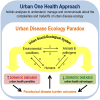Examining the paradox of urban disease ecology by linking the perspectives of Urban One Health and Ecology with Cities
- PMID: 35855439
- PMCID: PMC9283848
- DOI: 10.1007/s11252-022-01260-5
Examining the paradox of urban disease ecology by linking the perspectives of Urban One Health and Ecology with Cities
Abstract
The ecology of zoonotic, including vector-borne, diseases in urban social-ecological systems is influenced by complex interactions among human and environmental factors. Several characteristics contribute to the emergence and spread of infectious diseases in urban places, such as high human population densities, favorable habitat for vectors, and humans' close proximity to animals and their pathogens. On the other hand, urban living can contribute to the improvement of public health through better access to health services and creation of ecological and technological infrastructure that reduces disease burdens. Therefore, urbanization creates a disease ecology paradox through the interplay of urban health penalties and advantages for individual and community outcomes. To address this contradiction, we advocate a holistic Urban One Health perspective for managing urban systems, especially their green spaces and animal populations, in ways that more effectively control the spread of zoonotic diseases. This view should be coupled with an Ecology with Cities approach which emphasizes actionable science needed for urban planning, management and policymaking; developing disease and vector surveillance programs using citizen and community science methods; and improving education and communication actions that help diverse stakeholders understand the complexities of urban disease ecology. Such measures will enable scholars from many disciplines to collaborate with professionals, government officials, and others to tackle challenges of the urban disease paradox and create more sustainable, health-promoting environments.
Keywords: Community science; Infectious diseases; Public health; Urban disease ecology; Vectors; Zoonosis.
© The Author(s), under exclusive licence to Springer Science+Business Media, LLC, part of Springer Nature 2022.
Conflict of interest statement
Conflict of interestLoren B. Byrne is on the editorial board of Urban Ecosystems, but did not participate in the review of this article. No other conflicts of interest to declare.
Figures

References
-
- Amaku M, Dias RA, Ferreira F. Dynamics and control of stray dog populations. Math Popul Stud. 2010;17:69–78. doi: 10.1080/08898481003689452. - DOI
LinkOut - more resources
Full Text Sources
